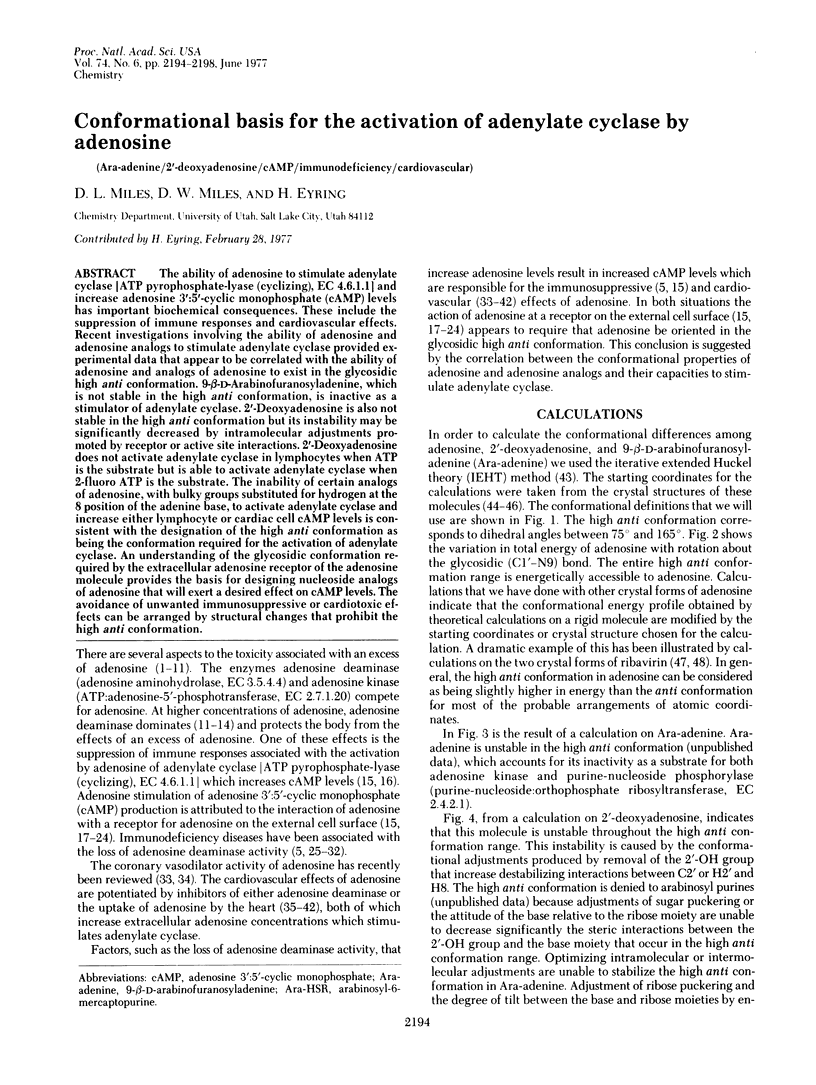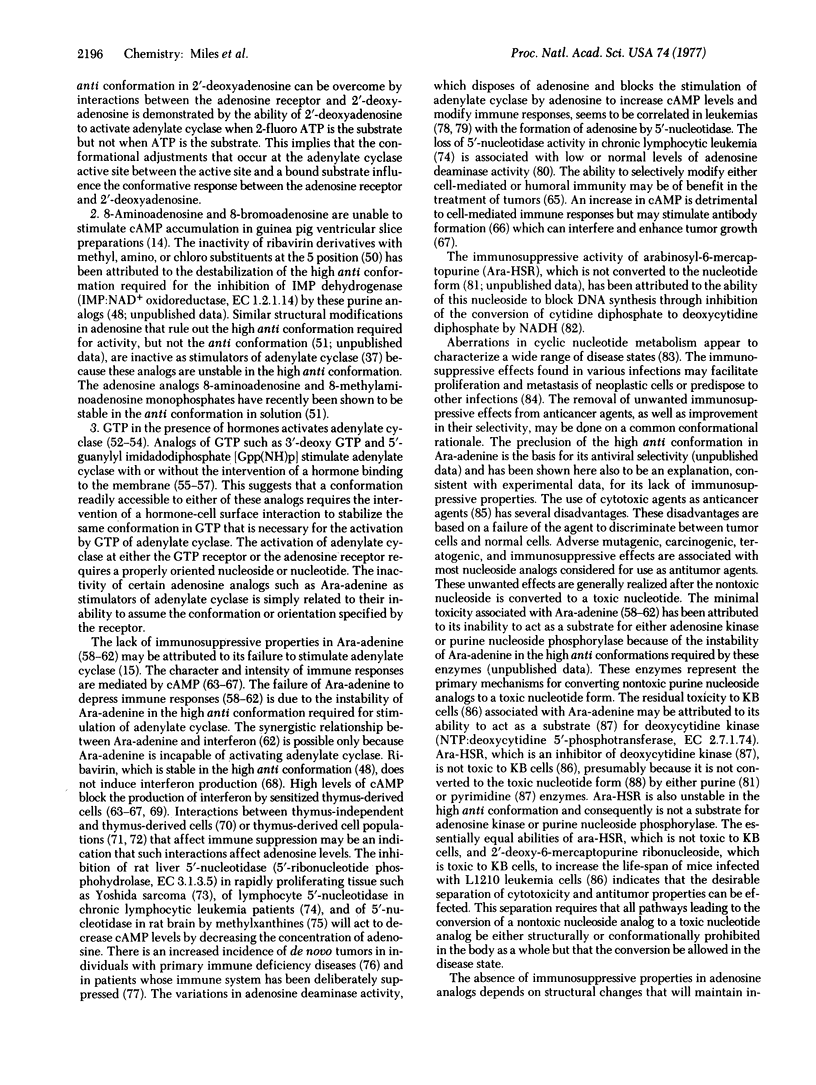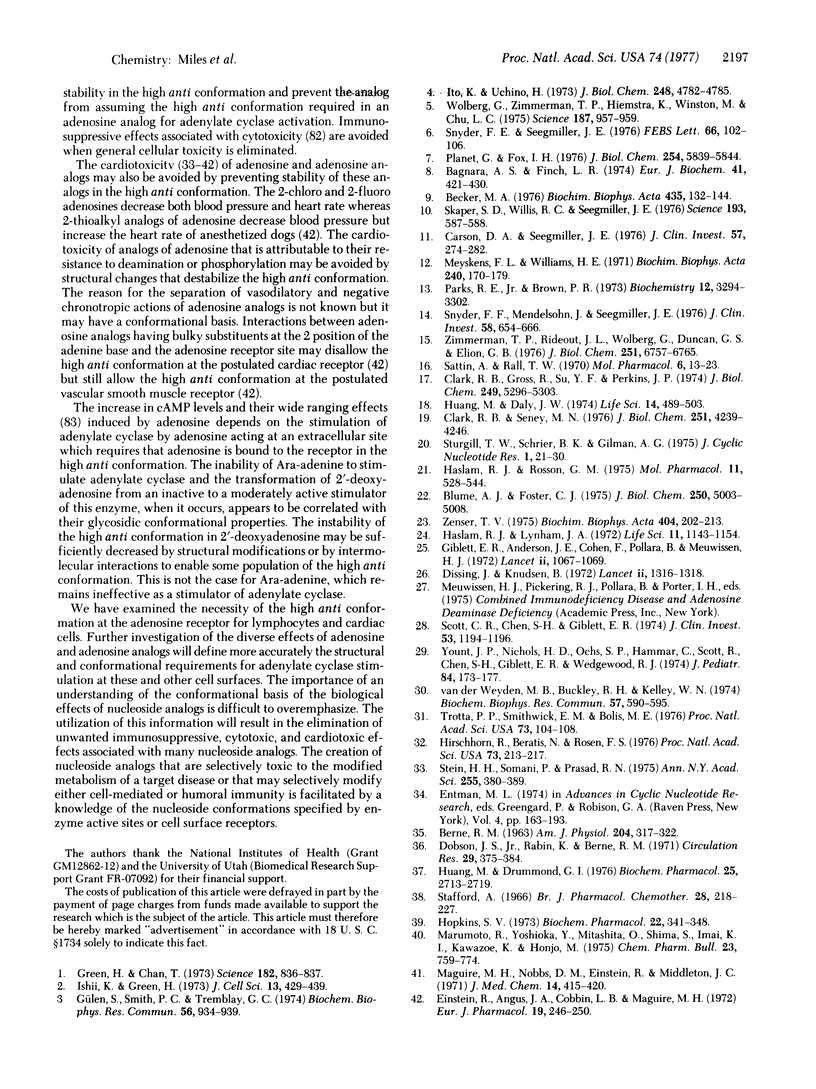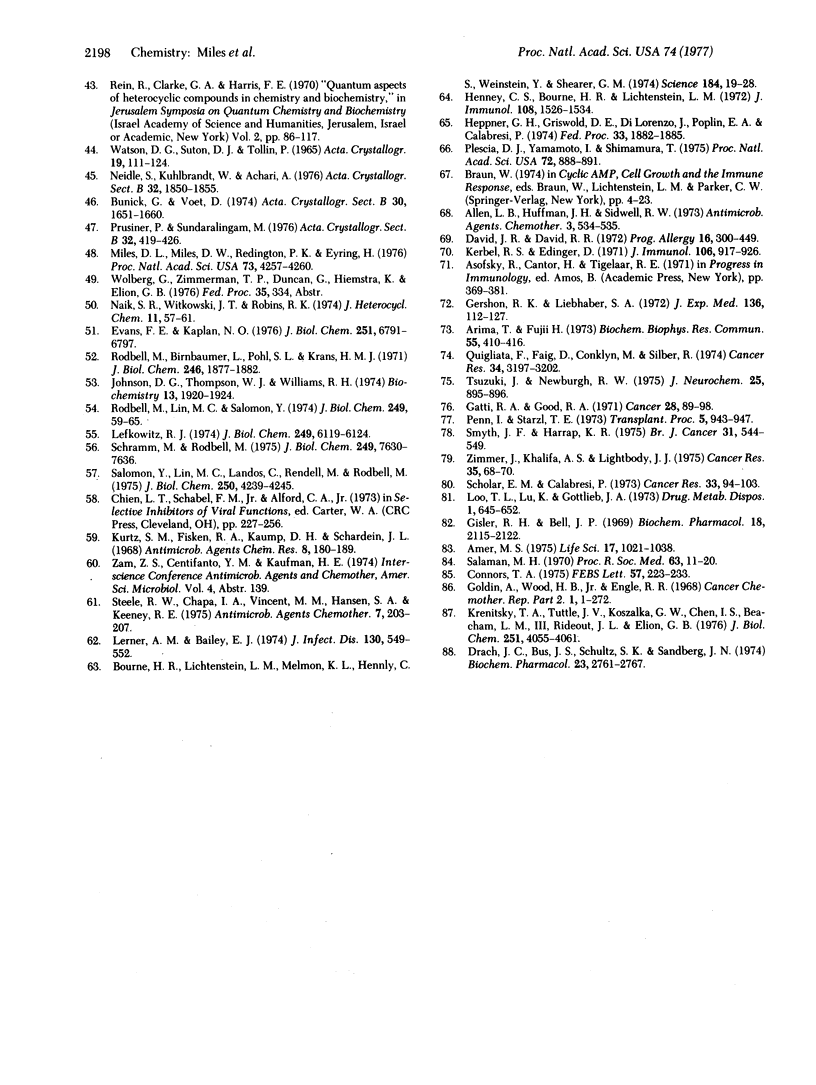Abstract
The ability of adenosine to stimulate adenylate cyclase [ATP pyrophosphate-lyase (cyclizing), EC 4.6.1.1] and increase adenosine 3′:5′-cyclic monophosphate (cAMP) levels has important biochemical consequences. These include the suppression of immune responses and cardiovascular effects. Recent investigations involving the ability of adenosine and adenosine analogs to stimulate adenylate cyclase provided experimental data that appear to be correlated with the ability of adenosine and analogs of adenosine to exist in the glycosidic high anti conformation. 9-β-D-Arabinofuranosyladenine, which is not stable in the high anti conformation, is inactive as a stimulator of adenylate cyclase. 2′-Deoxyadenosine is also not stable in the high anti conformation but its instability may be significantly decreased by intramolecular adjustments promoted by receptor or active site interactions. 2′-Deoxyadenosine does not activate adenylate cyclase in lymphocytes when ATP is the substrate but is able to activate adenylate cyclase when 2-fluoro ATP is the substrate. The inability of certain analogs of adenosine, with bulky groups substituted for hydrogen at the 8 position of the adenine base, to activate adenylate cyclase and increase either lymphocyte or cardiac cell cAMP levels is consistent with the designation of the high anti conformation as being the conformation required for the activation of adenylate cyclase. An understanding of the glycosidic conformation required by the extracellular adenosine receptor of the adenosine molecule provides the basis for designing nucleoside analogs of adenosine that will exert a desired effect on cAMP levels. The avoidance of unwanted immunosuppressive or cardiotoxic effects can be arranged by structural changes that prohibit the high anti conformation.
Keywords: Ara-adenine, 2′-deoxyadenosine, cAMP, immunodeficiency, cardiovascular
Full text
PDF




Selected References
These references are in PubMed. This may not be the complete list of references from this article.
- Allen L. B., Huffman J. H., Sidwell R. W. Failure of 1-beta-D-ribofuranosyl-1,2,4-triazole-3-carboxamide (virazole, ICN 1229) to stimllate interferon. Antimicrob Agents Chemother. 1973 Apr;3(4):534–535. doi: 10.1128/aac.3.4.534. [DOI] [PMC free article] [PubMed] [Google Scholar]
- Amer M. S. Cyclic nucleotides in disease; on the biochemical etiology of hypertension. Life Sci. 1975 Oct 10;17(7):1021–1038. doi: 10.1016/0024-3205(75)90321-5. [DOI] [PubMed] [Google Scholar]
- Arima T., Fujii S. Inhibitor of pyrimidine metabolism from tumor tissues. Biochem Biophys Res Commun. 1973 Nov 16;55(2):410–416. doi: 10.1016/0006-291x(73)91102-9. [DOI] [PubMed] [Google Scholar]
- BERNE R. M. Cardiac nucleotides in hypoxia: possible role in regulation of coronary blood flow. Am J Physiol. 1963 Feb;204:317–322. doi: 10.1152/ajplegacy.1963.204.2.317. [DOI] [PubMed] [Google Scholar]
- Bagnara A. S., Finch L. R. The effects of bases and nucleosides on the intracellular contents of nucleotides and 5-phosphoribosyl 1-pyrophosphate in Escherichia coli. Eur J Biochem. 1974 Feb 1;41(3):421–430. doi: 10.1111/j.1432-1033.1974.tb03283.x. [DOI] [PubMed] [Google Scholar]
- Becker M. A. Regulation of purine nucleotide synthesis. Effects of inosine on normal and hypoxantine-guanine phosphoribosyltransferase-deficient fibroblasts. Biochim Biophys Acta. 1976 Jun 18;435(2):132–144. doi: 10.1016/0005-2787(76)90244-6. [DOI] [PubMed] [Google Scholar]
- Blume A. J., Foster C. J. Mouse neuroblastoma adenylate cyclase. Adenosine and adenosine analogues as potent effectors of adenylate cyclase activity. J Biol Chem. 1975 Jul 10;250(13):5003–5008. [PubMed] [Google Scholar]
- Bourne H. R., Lichtenstein L. M., Melmon K. L., Henney C. S., Weinstein Y., Shearer G. M. Modulation of inflammation and immunity by cyclic AMP. Science. 1974 Apr 5;184(4132):19–28. doi: 10.1126/science.184.4132.19. [DOI] [PubMed] [Google Scholar]
- Carson D. A., Seegmiller J. E. Effect of adenosine deaminase inhibition upon human lymphocyte blastogenesis. J Clin Invest. 1976 Feb;57(2):274–282. doi: 10.1172/JCI108278. [DOI] [PMC free article] [PubMed] [Google Scholar]
- Clark R. B., Gross R., Su Y. F., Perkins J. P. Regulation of adenosine 3':5'-monophosphate content in human astrocytoma cells by adenosine and the adenine nucleotides. J Biol Chem. 1974 Aug 25;249(16):5296–5303. [PubMed] [Google Scholar]
- Clark R. B., Seney M. N. Regulation of adenylate cyclase from cultured human cell lines by adenosine. J Biol Chem. 1976 Jul 25;251(14):4239–4246. [PubMed] [Google Scholar]
- Connors T. A. Drugs used in the treatment of cancer. FEBS Lett. 1975 Oct 1;57(3):223–233. doi: 10.1016/0014-5793(75)80305-x. [DOI] [PubMed] [Google Scholar]
- David J. R., David R. R. Cellular hypersensitivity and immunity. Inhibition of macrophage migration and the lymphocyte mediators. Prog Allergy. 1972;16:300–449. [PubMed] [Google Scholar]
- Dissing J., Knudsen B. Adenosine-deaminase deficiency and combined immunodeficiency syndrome. Lancet. 1972 Dec 16;2(7790):1316–1316. doi: 10.1016/s0140-6736(72)92692-x. [DOI] [PubMed] [Google Scholar]
- Dobson J. G., Jr, Rubio R., Berne R. M. Role of adenine nucleotides, adenosine, and inorganic phosphate in the regulation of skeletal muscle blood flow. Circ Res. 1971 Oct;29(4):375–384. doi: 10.1161/01.res.29.4.375. [DOI] [PubMed] [Google Scholar]
- Drach J. C., Bus J. S., Schultz S. K., Sandberg J. N. Biotransformation of 9-beta-D-arabinofurano-syladenine by rat and human erythrocytes. Biochem Pharmacol. 1974 Oct 1;23(19):2761–2767. doi: 10.1016/0006-2952(74)90046-x. [DOI] [PubMed] [Google Scholar]
- Einstein R., Angus J. A., Cobbin L. B., Maguire M. H. Separation of vasodilator and negative chronotropic actions in analogues of adenosine. Eur J Pharmacol. 1972 Aug;19(2):246–250. doi: 10.1016/0014-2999(72)90016-7. [DOI] [PubMed] [Google Scholar]
- Evans F. E., Kaplan N. O. 8-Alkylaminoadenyl nucleotides as probes of dehydrogenase interactions with nucleotide analogs of different glycosyl conformation. J Biol Chem. 1976 Nov 10;251(21):6791–6797. [PubMed] [Google Scholar]
- Gatti R. A., Good R. A. Occurrence of malignancy in immunodeficiency diseases. A literature review. Cancer. 1971 Jul;28(1):89–98. doi: 10.1002/1097-0142(197107)28:1<89::aid-cncr2820280117>3.0.co;2-q. [DOI] [PubMed] [Google Scholar]
- Gershon R. K., Liebhaber S. A. The response of T cells to histocompatibility-2 antigens. Dose-response kinetics. J Exp Med. 1972 Jul 1;136(1):112–127. doi: 10.1084/jem.136.1.112. [DOI] [PMC free article] [PubMed] [Google Scholar]
- Giblett E. R., Anderson J. E., Cohen F., Pollara B., Meuwissen H. J. Adenosine-deaminase deficiency in two patients with severely impaired cellular immunity. Lancet. 1972 Nov 18;2(7786):1067–1069. doi: 10.1016/s0140-6736(72)92345-8. [DOI] [PubMed] [Google Scholar]
- Gisler R. H., Bell J. P. Studies on immunosuppression by purine nucleoside analogues. I. Effects on the immune response to sheep red blood cells in mice. Biochem Pharmacol. 1969 Sep;18(9):2115–2122. doi: 10.1016/0006-2952(69)90316-5. [DOI] [PubMed] [Google Scholar]
- Goldin A., Wood H. B., Jr, Engle R. R. Relation of structure of purine and pyrimidine nucleosides to antitumor activity. Cancer Chemother Rep 2. 1968 Oct;1(1):1–272. [PubMed] [Google Scholar]
- Green H., Chan T. Pyrimidine starvation induced by adenosine in fibroblasts and lymphoid cells: role of adenosine deaminase. Science. 1973 Nov 23;182(4114):836–837. doi: 10.1126/science.182.4114.836. [DOI] [PubMed] [Google Scholar]
- Gülen S., Smith P. C., Tremblay G. C. Evidence from the control of pyrimidine biosynthesis in tissue minces by purines. Biochem Biophys Res Commun. 1974 Feb 27;56(4):934–939. doi: 10.1016/s0006-291x(74)80278-0. [DOI] [PubMed] [Google Scholar]
- Haslam R. J., Lynham J. A. Activation and inhibition of blood platelet adenylate cyclase by adenosine or by 2-chloroadenosine. Life Sci II. 1972 Dec 8;11(23):1143–1154. doi: 10.1016/0024-3205(72)90269-x. [DOI] [PubMed] [Google Scholar]
- Haslam R. J., Rosson G. M. Effects of adenosine on levels of adenosine cyclic 3',5'-monophosphate in human blood platelets in relation to adenosine incorporation and platelet aggregation. Mol Pharmacol. 1975 Sep;11(5):528–544. [PubMed] [Google Scholar]
- Henney C. S., Bourne H. R., Lichtenstein L. M. The role of cyclic 3',5' adenosine monophosphate in the specific cytolytic activity of lymphocytes. J Immunol. 1972 Jun;108(6):1526–1534. [PubMed] [Google Scholar]
- Heppner G. H., Griswold D. E., Di Lorenzo J., Poplin E. A., Calabresi P. Selective immunosuppression by drugs in balanced immune responses. Fed Proc. 1974 Aug;33(8):1882–1885. [PubMed] [Google Scholar]
- Hirschhorn R., Beratis N., Rosen F. S. Characterization of residual enzyme activity in fibroblasts from patients with adenosine deaminase deficiency and combined immunodeficiency: evidence for a mutant enzyme. Proc Natl Acad Sci U S A. 1976 Jan;73(1):213–217. doi: 10.1073/pnas.73.1.213. [DOI] [PMC free article] [PubMed] [Google Scholar]
- Hopkins S. V. The potentiation of the action of adenosine on the guinea-pig heart. Biochem Pharmacol. 1973 Feb 1;22(3):341–348. doi: 10.1016/0006-2952(73)90415-2. [DOI] [PubMed] [Google Scholar]
- Huang M., Daly J. W. Adenosine-elicited accumulation of cyclic AMP in brain slices: potentiation by agents which inhibit uptake of adenosine. Life Sci. 1974 Feb 1;14(3):489–503. doi: 10.1016/0024-3205(74)90364-6. [DOI] [PubMed] [Google Scholar]
- Huang M., Drummond G. I. Effect of adenosine on cyclic AMP accumulation in ventricular myocardium. Biochem Pharmacol. 1976 Dec 15;25(24):2713–2719. doi: 10.1016/0006-2952(76)90262-8. [DOI] [PubMed] [Google Scholar]
- Ishii K., Green H. Lethality of adenosine for cultured mammalian cells by interference with pyrimidine biosynthesis. J Cell Sci. 1973 Sep;13(2):429–439. doi: 10.1242/jcs.13.2.429. [DOI] [PubMed] [Google Scholar]
- Ito K., Uchino H. Control of pyrimidine biosynthesis in human lymphocytes. Inhibition of pyrimidine biosynthesis de novo in phytohemagglutinin-stimulated lymphocytes by external uridine and its inhibition mechanism. J Biol Chem. 1973 Jul 10;248(13):4782–4785. [PubMed] [Google Scholar]
- Johnson D. G., Thompson W. J., Williams R. H. Regulation of adenylyl cyclase from isolated pancretic islets by prostaglandins and guanosine 5'-triphosphate. Biochemistry. 1974 Apr 23;13(9):1920–1924. doi: 10.1021/bi00706a022. [DOI] [PubMed] [Google Scholar]
- Kerbel R. S., Eidinger D. Variable effects of anti-lymphocyte serum on humoral antibody formation: role of thymus dependency of antigen. J Immunol. 1971 Apr;106(4):917–926. [PubMed] [Google Scholar]
- Krenitsky T. A., Tuttle J. V., Koszalka G. W., Chen I. S., Beacham L. M., 3rd, Rideout J. L., Elion G. B. Deoxycytidine kinase from calf thymus. Substrate and inhibitor specificity. J Biol Chem. 1976 Jul 10;251(13):4055–4061. [PubMed] [Google Scholar]
- Kurtz S. M., Fisken R. A., Kaump D. H., Schardn J. L. Toxicity of 9-beta-D-arabinofuranosyladenine in mice and rabbits. Antimicrob Agents Chemother (Bethesda) 1968;8:180–189. [PubMed] [Google Scholar]
- Lefkowitz R. J. Stimulation of catecholamine-sensitive adenylate cyclase by 5'-guanylyl-imidodiphosphate. J Biol Chem. 1974 Oct 10;249(19):6119–6124. [PubMed] [Google Scholar]
- Lerner A. M., Bailey E. J. Synergy of 9-beta-D-arabinofuranosyladenine and human interferon against Herpes simplex virus, type 1. J Infect Dis. 1974 Nov;130(5):549–552. doi: 10.1093/infdis/130.5.549. [DOI] [PubMed] [Google Scholar]
- Loo T. L., Lu K., Gottlieb J. A. Disposition and metabolism of thiopurines. II. Arabinosyl-6-mercaptopurine and ribosyl-6-mercaptopurine. Drug Metab Dispos. 1973 Jul-Aug;1(4):645–652. [PubMed] [Google Scholar]
- Maguire M. H., Nobbs D. M., Einstein R., Middleton J. C. 2-Alkylthioadenosines, specific coronary vasodilators. J Med Chem. 1971 May;14(5):415–420. doi: 10.1021/jm00287a010. [DOI] [PubMed] [Google Scholar]
- Marumoto R., Yoshioka Y., Miyashita O., Shima S., Imai K. Synthesis and coronary vasodilating activity of 2-substituted adenosines. Chem Pharm Bull (Tokyo) 1975 Apr;23(4):759–774. doi: 10.1248/cpb.23.759. [DOI] [PubMed] [Google Scholar]
- Meyskens F. L., Williams H. E. Adenosine metabolism in human erythrocytes. Biochim Biophys Acta. 1971 Jun 30;240(2):170–179. doi: 10.1016/0005-2787(71)90654-x. [DOI] [PubMed] [Google Scholar]
- Miles D. L., Miles D. W., Redington P., Eyring H. Theoretical studies of the conformational properties of ribavirin. Proc Natl Acad Sci U S A. 1976 Dec;73(12):4257–4260. doi: 10.1073/pnas.73.12.4257. [DOI] [PMC free article] [PubMed] [Google Scholar]
- Parks R. E., Jr, Brown P. R. Incorporation of nucleosides into the nucleotide pools of human erythrocytes. Adenosine and its analogs. Biochemistry. 1973 Aug 14;12(17):3294–3302. doi: 10.1021/bi00741a022. [DOI] [PubMed] [Google Scholar]
- Penn I., Starzl T. E. Immunosuppression and cancer. Transplant Proc. 1973 Mar;5(1):943–947. [PMC free article] [PubMed] [Google Scholar]
- Planet G., Fox I. H. Inhibition of phosphoribosylpyrophosphate synthesis by purine nucleosides in human erythrocytes. J Biol Chem. 1976 Oct 10;251(19):5839–5844. [PubMed] [Google Scholar]
- Plescia O. J., Yamamoto I., Shimamura T. Cyclic AMP and immune responses: changes in the splenic level of cyclic AMP during the response of mice to antigen. Proc Natl Acad Sci U S A. 1975 Mar;72(3):888–891. doi: 10.1073/pnas.72.3.888. [DOI] [PMC free article] [PubMed] [Google Scholar]
- Quagliata F., Faig D., Conklyn M., Silber R. Studies on the lymphocyte 5'-nucleotidase in chronic lymphocytic leukemia, infectious mononucleosis, normal subpopulations, and phytohemagglutinin-stimulated cells. Cancer Res. 1974 Dec;34(12):3197–3202. [PubMed] [Google Scholar]
- Rodbell M., Birnbaumer L., Pohl S. L., Krans H. M. The glucagon-sensitive adenyl cyclase system in plasma membranes of rat liver. V. An obligatory role of guanylnucleotides in glucagon action. J Biol Chem. 1971 Mar 25;246(6):1877–1882. [PubMed] [Google Scholar]
- Rodbell M., Lin M. C., Salomon Y. Evidence for interdependent action of glucagon and nucleotides on the hepatic adenylate cyclase system. J Biol Chem. 1974 Jan 10;249(1):59–65. [PubMed] [Google Scholar]
- Salomon Y., Lin M. C., Londos C., Rendell M., Rodbell M. The hepatic adenylate cyclase system. I. Evidence for transition states and structural requirements for guanine nucloetide activiation. J Biol Chem. 1975 Jun 10;250(11):4239–4245. [PubMed] [Google Scholar]
- Sattin A., Rall T. W. The effect of adenosine and adenine nucleotides on the cyclic adenosine 3', 5'-phosphate content of guinea pig cerebral cortex slices. Mol Pharmacol. 1970 Jan;6(1):13–23. [PubMed] [Google Scholar]
- Scholar E. M., Calabresi P. Identification of the enzymatic pathways of nucleotide metabolism in human lymphocytes and leukemia cells. Cancer Res. 1973 Jan;33(1):94–103. [PubMed] [Google Scholar]
- Scott C. R., Chen S. H., Giblett E. R. Detection of the carrier state in combined immunodeficiency disease associated with adenosine deaminase deficiency. J Clin Invest. 1974 Apr;53(4):1194–1196. doi: 10.1172/JCI107658. [DOI] [PMC free article] [PubMed] [Google Scholar]
- Skaper S. D., Willis R. C., Seegmiller J. E. Cholera toxin-peroxidase: changes in surface labeling of glioblastoma cells with increased time in tissue culture. Science. 1976 Aug 13;193(4253):587–588. doi: 10.1126/science.959817. [DOI] [PubMed] [Google Scholar]
- Smyth J. F., Harrap K. R. Adenosine deaminase activity in leukaemia. Br J Cancer. 1975 May;31(5):544–549. doi: 10.1038/bjc.1975.95. [DOI] [PMC free article] [PubMed] [Google Scholar]
- Snyder F. F., Mendelsohn J., Seegmiller J. E. Adenosine metabolism in phytohemagglutinin-stimulated human lymphocytes. J Clin Invest. 1976 Sep;58(3):654–666. doi: 10.1172/JCI108512. [DOI] [PMC free article] [PubMed] [Google Scholar]
- Snyder F. F., Seegmiller J. E. The adenosine-like effect of exogenous cyclic AMP upon nucleotide and PP-ribose-P concentrations of cultured human lymphoblasts. FEBS Lett. 1976 Jul 1;66(1):102–106. doi: 10.1016/0014-5793(76)80595-9. [DOI] [PubMed] [Google Scholar]
- Stafford A. Potentiation of adenosine and the adenine nucleotides by dipyridamole. Br J Pharmacol Chemother. 1966 Nov;28(2):218–227. doi: 10.1111/j.1476-5381.1966.tb01888.x. [DOI] [PMC free article] [PubMed] [Google Scholar]
- Steele R. W., Chapa I. A., Vincent M. M., Hensen S. A., Keeney R. E. Effects of adenine arabinoside on cellular immune mechanisms in humans. Antimicrob Agents Chemother. 1975 Feb;7(2):203–207. doi: 10.1128/aac.7.2.203. [DOI] [PMC free article] [PubMed] [Google Scholar]
- Stein H. H., Somani P., Prasad R. N. Cardiovascular effects of nucleoside analogs. Ann N Y Acad Sci. 1975 Aug 8;255:380–389. doi: 10.1111/j.1749-6632.1975.tb29246.x. [DOI] [PubMed] [Google Scholar]
- Trotta P. P., Smithwick E. M., Balis M. E. A normal level of adenosine deaminase activity in the red cell lysates of carriers and patients with severe combined immunodeficiency disease. Proc Natl Acad Sci U S A. 1976 Jan;73(1):104–108. doi: 10.1073/pnas.73.1.104. [DOI] [PMC free article] [PubMed] [Google Scholar]
- Tsuzuki J., Newburgh R. W. Inhibition of 5'-nucleotidase in rat brain by methylxanthines. J Neurochem. 1975 Dec;25(6):895–896. doi: 10.1111/j.1471-4159.1975.tb04424.x. [DOI] [PubMed] [Google Scholar]
- Van der Weyden M. B., Buckley R. H., Kelley W. N. Molecular form of adenosine deaminase in severe combined immunodeficiency. Biochem Biophys Res Commun. 1974 Apr 8;57(3):590–595. doi: 10.1016/0006-291x(74)90587-7. [DOI] [PubMed] [Google Scholar]
- Watson D. G., Sutor D. J., Tollin P. The crystal structure of deoxyadenosine monohydrate. Acta Crystallogr. 1965 Jul 10;19(1):111–124. doi: 10.1107/s0365110x65002852. [DOI] [PubMed] [Google Scholar]
- Wolberg G., Zimmerman T. P., Hiemstra K., Winston M., Chu L. C. Adenosine inhibition of lymphocyte-mediated cytolysis: possible role of cyclic adenosine monophosphate. Science. 1975 Mar 14;187(4180):957–959. doi: 10.1126/science.167434. [DOI] [PubMed] [Google Scholar]
- Yount J., Nichols P., Ochs H. D., Hammar S. P., Scott C. R., Chen S. H., Giblett E. R., Wedgwood R. J. Absence of erythrocyte adenosine deaminase associated with severe combined immunodeficiency. J Pediatr. 1974 Feb;84(2):173–177. doi: 10.1016/s0022-3476(74)80597-4. [DOI] [PubMed] [Google Scholar]
- Zenser T. V. Formation of adenosine 3',5'-monophosphate from adenosine in mouse thymocytes. Biochim Biophys Acta. 1975 Oct 9;404(2):202–213. doi: 10.1016/0304-4165(75)90326-8. [DOI] [PubMed] [Google Scholar]
- Zimmer J., Khalifa A. S., Lightbody J. J. Decreased lymphocyte adenosine deaminase activity in acute lymphocytic leukemia children and their parents. Cancer Res. 1975 Jan;35(1):68–70. [PubMed] [Google Scholar]
- Zimmerman T. P., Rideout J. L., Wolberg G., Duncan G. S., Elion G. B. 2-Fluoroadenosine 3':5'-monophosphate. A metabolite of 2-fluoroadenosine in mouse cytotoxic lymphocytes. J Biol Chem. 1976 Nov 10;251(21):6757–6766. [PubMed] [Google Scholar]


